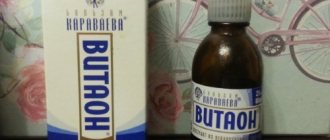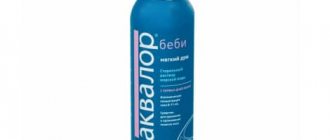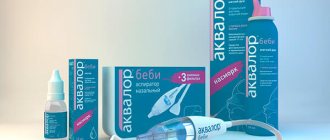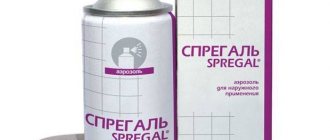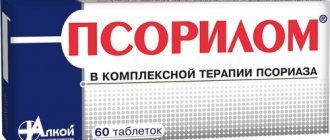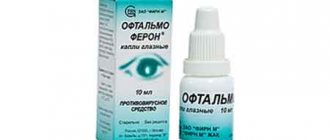The instructions for use indicate that Salin should be used in the event of diseases affecting the nasal pharynx and being inflammatory in nature. The remedy is also relevant when carrying out preventive measures against addiction to other medications with a vasoconstrictor effect. After using Salin spray, the patient will feel an improvement in the sensitivity of the nose and the receptivity of aromas around. If necessary, the product can be used in the form of drops, tilting the bottle down.
Release form and composition
Salin is a medicine in the form of a spray against the common cold. Prescribed to both adults and children, because the composition does not contain harmful components.
| Active substance |
|
| Compound | Salin is an isotonic 0.65% aqueous solution of sodium chloride. As additional components, the medicine contains:
|
| Release form | The product is produced in the form of a nasal spray, which is contained in polyethylene bottles of 30 or 44 ml. The bottle is equipped with a sprayer and is packed in a cardboard box. |
Salin
Name: Salin Pharmacological action: The mechanism of action of NaCl solutions is based mainly on the osmotic effect and completely depends on its concentration. Salin has an anticongestive (decongestant) pharmacological effect. When applied to the nasal mucosa, it has an anti-inflammatory effect and relieves swelling. If nasal breathing is difficult due to rhinitis, it facilitates nasal breathing by thinning thick mucus, softening dry crusts and removing them from the nasal passages. Highly purified 0.65% NaCl solution ideally matches physiological nasal secretions. Buffering substances in the composition (sodium dihydrogen phosphate dihydrate, sodium hydrogen phosphate dihydrate) stabilize the pH of the NaCl solution to the pH level of the natural secretory fluid of the mucous membrane, and also have an additional antiseptic (bactericidal, virusicidal, antifungal) effect due to the additional introduction of benzalkonium chloride. The use of Salin makes it possible to reduce the frequency and dose of using local vasoconstrictors, improve the transport and olfactory functions of the epithelium of the nasal mucosa, which helps restore nasal breathing and shortens the rehabilitation period after surgery.
Indications for use: 1. For atrophic, infectious, allergic rhinitis of various etiologies for the purpose of hygienic care of the nasal cavity and complex treatment of diseases of the nasal mucosa and its sinuses. 2. When using local vasoconstrictor drugs as an additional means to reduce addiction to the main drug. 3. For dry nasal mucosa caused by man-made factors affecting the microclimate of the room (air conditioners in cars and apartments, central radiators and local heating devices) and changes in barometric pressure during air travel and diving. 4. During the rehabilitation period after maxillofacial operations concerning the nasal cavity and its sinuses.
Directions for use: The spray can be used in three positions. Salin is sprayed into both nasal passages by actively pressing in a vertical position into the elastic body of the bottle. Dosage: adults: 2 sprays in each nasal passage three to four times a day. For young children, 1 spray three to four times a day. For infants, it is advisable to use the spray in an inverted position (in the form of drops) to avoid reflex spasmodic reactions. In a horizontal position, Salin flows out as a stream of liquid.
Side effects: No side effects were observed when the instructions for use were followed.
Contraindications: Changes in the acid-base balance of the body (acidosis), hypernatremia, hypokalemia, hyperchloremia, extracellular hyperhydration; symptoms of cerebral or pulmonary edema, decompensated heart and kidney failure.
Pregnancy: There are no restrictions for pregnant and nursing mothers. Salin can be used at any stage of pregnancy and lactation.
Interaction with other drugs: It is not advisable to use Salin simultaneously with the use of glucocorticosteroids in large doses.
Overdose: Cases of overdose have not been described in the medical literature. Salin does not affect the speed of the operator's reactions when operating various mechanisms and machines and does not cause drowsiness.
Release form: Nasal spray (30 and 44 ml bottles).
Storage conditions: Storage temperature no higher than 30 degrees Celsius. Store the drug in a dry place.
Synonyms: Sodium chloride (Natrii chloridum, Natrium chloratum, Sodium chloride), sodium chloride, sodium salt of hydrochloric acid, saline solution, table salt solution.
Composition: Isotonic 0.65% aqueous solution of sodium chloride. Additional ingredients: benzalkonium chloride, sodium dihydrogen phosphate dihydrate, sodium hydrogen phosphate dihydrate, purified water.
Additionally: Individual use of a spray atomizer is mandatory to prevent the transmission of an infectious disease to another person.
Attention! The description of the drug " Salin " on this page is a simplified and expanded version of the official instructions for use. Before purchasing or using the drug, you should consult your doctor and read the instructions approved by the manufacturer. Information about the drug is provided for informational purposes only and should not be used as a guide to self-medication. Only a doctor can decide to prescribe the drug, as well as determine the dose and methods of its use.
pharmachologic effect
Sodium and chloride ions are the most important inorganic components of the extracellular fluid, maintaining the appropriate osmotic pressure of the blood plasma and extracellular fluid.
An isotonic solution replenishes fluid deficiency in the body during dehydration. Hypertonic sodium chloride solution, when administered intravenously, provides correction of the osmotic pressure of extracellular fluid and blood plasma.
When applied topically in ophthalmology, sodium chloride has an anti-edematous effect.
Analogs
Aqualor
Aurena Laboratories AB, Canada
Price from 131 to 430 rubles.
A drug that contains an isotonic solution of sea water. It is used for the treatment and prevention of rhinitis resulting from the development of ARVI, influenza, as well as for the purpose of moisturizing the nasal cavity. Produced in spray form.
Pros:
- Available in the form of several drugs for different age groups
- Well moisturizes the nasal mucosa
- Can be prescribed to newborns.
Minuses:
- High price
- Use after surgery is possible only after consultation with the doctor.
AquaMaris
JSC Jadran Galenski Laboratories, Croatia
Price from 129 to 500 rubles.
The drug contains water from the Adriatic Sea and is used to moisturize the mucous membranes and rinse the nose in the treatment and prevention of diseases of the nasal cavity. Release form Aqua Marisa: drops, spray.
Pros:
- Quite an effective remedy for rhinitis
- Does not contain preservatives
- Used to treat runny nose in newborns.
Minuses:
- Contraindicated for frequent nosebleeds
- Should not be used for otitis media (children under 3 years of age)
- May cause allergic reactions.
Indications
Indications for use of Salin spray are:
- for hygienic care of the nasal cavity, prevention and complex treatment of diseases of the nasal mucosa and paranasal sinuses, accompanied by dryness of the nasal mucosa or the formation of abundant nasal mucus (atrophic, allergic, infectious, medicinal rhinitis);
- as part of complex therapy as an adjuvant when using local vasoconstrictor drugs;
- to eliminate dryness of the nasal mucosa caused by air-conditioned rooms, cars, as well as the operation of central heating radiators, air travel;
- rhinitis of various etiologies. In this case, Salin is recommended as a safe means for maintaining hygiene in the nasal cavity and for the comprehensive fight against various diseases of the nose and its sinuses;
- with severe dryness of the mucous membrane in the nose, which is caused by various man-made factors, for example, sharp changes in barometric pressure during diving or flights;
- during recovery after undergoing major maxillofacial surgeries affecting the nose and sinuses.
Pharmacological properties of the drug Salin
Effectively moisturizes the nasal mucosa, thins thick nasal mucus, softens dry crusts and facilitates their easy removal. Highly purified, stabilized 0.65% sodium chloride solution closely matches natural nasal secretions. The buffering substances included in Salina bring the pH of the solution closer to the pH of the natural secretion of the nasal mucosa and maintain this indicator at a constant level. Salin improves the sense of smell and the transport function of the ciliated epithelium, helps restore nasal breathing, shortens the rehabilitation period and allows you to reduce the dose and frequency of use of local vasoconstrictors.
Contraindications
- Contraindications to the use of Salin include the impossibility of using the medicine if there is hypersensitivity to its main components. This can lead to an allergic reaction of varying complexity. Therefore, the risk in this case may not be justified.
- If the acid-base balance in the body is disturbed, the medication should not be used under any circumstances. Excess sodium ions in the blood, lack of potassium and even extracellular dehydration completely exclude the possibility of treatment with this drug.
- In case of cerebral or pulmonary edema, there is also a certain prohibition. You should not take the drug if your heart or kidney function is impaired. That is why the medicine should be used only after consultation with a doctor.
Any independent intervention can lead to serious consequences. Salin does not contain harmful components, but it can cause an allergic reaction.
How to use the spray correctly
If you study the instructions for use in detail, you will find information that Salin nasal drops are used in 3 positions. If the bottle is positioned vertically, aerosol spraying occurs. It is necessary to administer the medicine into both nostrils.
If the patient is an adult, you need to spray the medicine 2 times in both turns. This procedure is repeated up to 4 times in 24 hours.
To treat children, the number of sprays must be reduced by half. Speaking of therapy for infants, it is better to instill this remedy like regular drops. To do this, just turn the bottle over. This must be done in order to prevent reflex spasmodic manifestations. If the bottle is held horizontally, the solution will flow out in one stream. A few minutes after administration of the drug, you should thoroughly clean your nose of any secretions present there.
Is it possible to take Salin if a woman is pregnant?
The instructions for use do not contain any information about prohibiting the use of Salin spray during pregnancy. The only rule that women carrying a child should adhere to is not to purchase this product without a doctor’s prescription. He must also determine the frequency of administration and the number of sprays. The same goes for mothers who are breastfeeding.
Instructions for use of the spray
Before use, be sure to consult with your ENT doctor and read the instructions for the drug.
Salin for adults
Spray inside the nasal cavity by quickly pressing the elastic body of the bottle. When spraying, do not tilt your head back or turn the bottle over. For adults – 2 sprays in each nostril.
Application:
- when the bottle is held vertically, the solution is released from it in the form of an aerosol;
- in horizontal – in the form of a jet of liquid;
- in an inverted position - drop by drop.
The duration of treatment is determined by the attending physician.
Instructions for children
- For children over one year old, one drop is prescribed in each nasal passage or one injection of the drug, two to three times a day.
Salin for newborns is an effective and safe remedy for relieving symptoms. With its help, you can easily clean the nasal cavity and alleviate the baby’s condition with rhinitis.
At the same time, doctors categorically do not recommend using vasoconstrictor medications to treat children. Salin does not irritate the baby's nasal mucosa.
You can use the medicine to treat newborns after consultation with your pediatrician.
Description of the drug
Salin is produced in European countries, as well as the European Union. Sagmel has been presenting its pharmaceutical products on the Russian market for a long time. All medications, including Salin, undergo clinical trials before going on sale. Based on the opinions of patients and doctors, we can conclude that all of them are effective and of high quality.
Salin will allow a person to quickly get rid of inflammatory diseases, as it promotes rapid cleaning of the nose, which prevents the proliferation of pathogenic bacteria.
How to eliminate dryness: 5 simple ways
Chamomile decoction is perfect for rinsing the nose.
Ready-made saline solutions and other anti-dryness remedies can be purchased at the pharmacy. They're called:
- Aqua Maris;
- Aqualor;
- Salin;
- Otrivin (spray);
- Balm Narisan;
- Balm Vitaon;
- Salicylic ointment.
It is important to know that pharmaceutical saline solutions are prepared on the basis of natural sea water, due to which they act gently and effectively.
Drinking plenty of fluids and maintaining an optimal level of humidity in the room will help get rid of dryness. It is also recommended to regularly do wet cleaning and ventilate the room. It is not advisable to use vasoconstrictor drops, but if this is not possible, then it is better to limit their use.
Why does my nose get dry?
Dry nose with coronavirus is a typical sign of infection and occurs due to the lack of natural hydration of the mucous membranes. This leads to irritation and discomfort, an unpleasant burning sensation.
The nasal passages become swollen, causing congestion and making it difficult to breathe. In the driest places, crusts may form. Due to constant dryness, even for 1-2 days, microcracks may appear. Small wounds facilitate the penetration of infection into the epithelium and contribute to the progression of the disease.
Additional factors that cause or intensify drying of the nasal mucosa may be:
- infectious and inflammatory processes in the gastrointestinal tract - gastrointestinal tract;
- prolonged psycho-emotional overload;
- weakened immune system;
- diabetes;
- long-term use of vasoconstrictor nasal drops;
- deviated nasal septum;
- dry indoor air;
- smoking;
- hormonal imbalances.
Sticking in the nose is not a completely harmless symptom, although it accompanies most colds. It causes headaches, nosebleeds, decreased sense of smell, sneezing and impairs sleep.
